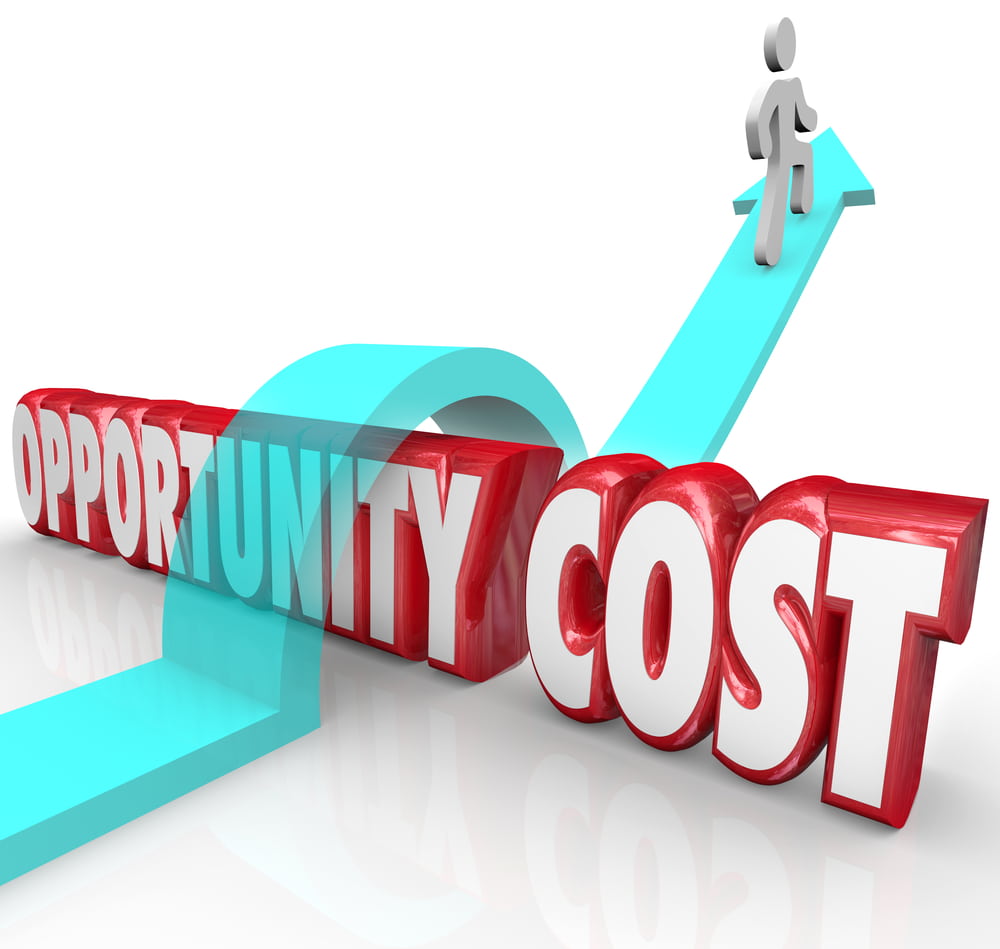Whether you are new to investing or have been making investment decisions for a while, knowing how to calculate opportunity cost is important. It allows you to be able to make decisions between investment opportunities.
You can look at two investment opportunities subjectively and then decide which one is the best for you in the current situation. Discussing opportunity costs and learning how to calculate them is important for you as an investor to make sure you are making the right financial choices.
What Is Opportunity Cost?
Opportunity cost can be viewed as a trade-off. This means you have to make one decision over another. With opportunity cost, you can decide which decision makes more sense economically.
Say you are presented with two investment opportunities, but you can only afford to invest in one. You need to analyze the situation and invest in the opportunity that makes the most financial sense both in the short term and the long term.
With opportunity cost, you have to choose one alternative or another. It’s important to understand opportunity cost because it allows you to see opportunities you missed out on and how they compare the opportunities that you took, whether it be for better or for worse.
You always want to choose the option that benefits you the most so that you are always making good financial decisions.
[ Thinking about investing in real estate? Register to attend a FREE online real estate class and learn how to get started investing in real estate. ]

How Does Opportunity Cost Work?
When looking at opportunity cost, you are looking for the potential of the cost. You can use calculations and formulas, but they might not always be accurate since the future cannot be predicted completely. With you are calculating the opportunity cost, you will always be using estimates.
While opportunity cost is mostly used by investors, you can use opportunity cost in many areas of life, including work, school, and your personal life.
As with many things when it comes to investing, opportunity cost has limitations. This is because you can only study the history and current terms of investment; there is no way to know for sure how the investment will do in the future.
This means opportunity cost will never truly be accurate until you can look back on the choice you made and see how it compares to the choice you avoided.
While investments are mostly about money, there are certain things that factor into opportunity costs that cannot be assigned a specific dollar amount. Liquidity is one example. You might have chosen an investment that ties your cash up for a certain amount of years and then adds interest to it.
While this seems like a good plan, consider the fact that this ties up some of your money, and you might not have access to it if you need it for another investment. While opportunity cost is important, it fails in some areas because of the limitations when it comes to not being able to analyze things that don’t have a specific dollar amount.
Opportunity Cost Formula
When you calculate opportunity cost, you are simply finding the difference between the two expected returns for each of the options you have. Here is the basic formula for opportunity cost:
Opportunity Cost= FO-CO
FO stands for return on forgone option, and CO stands for return on the chosen option.
Anytime you are calculating the opportunity cost, you are comparing the return on both of the investment options you have in front of you. This will also allow you to monitor future returns. You can also use this formula when you are looking back in hindsight because it allows you to see if you made the right decision or not.
Opportunity Cost Example
It can be hard to really learn about opportunity cost when reading the definition and seeing the formula. Sometimes it helps to use a real-world example and not an investment opportunity to show what we mean when we say opportunity cost.
You make spending decisions every day in your life. Some might seem minuscule, but they make more of a difference than you might think, especially when you are looking further into the future.
One of the main issues is that you might be spending small dollar amounts every day without failing to think about the lost opportunities you have because you are not saving more money for the future.
For example, your morning coffee might only cost $4. If you buy one each day on the way to work, you are spending $20 a week. That’s over $1,000 a year. It might not seem like much at the time, but if you do this for the next 15 years that you are going to the office, then you have spent $15,000 on coffee without even realizing how much that money could be used for an investment or something else.
This example is a lot simpler than one of investing. However, it shows you how money can be easily spent on something that can take away from other opportunities, whether they have to do with investing or not.
You don’t have to think about opportunity costs every time you make a small purchase. It’s good to be aware though of how spending even tiny amounts can affect your future to make other larger financial decisions.
Opportunity Cost Vs. Sunk Cost
Many people wonder about the difference between opportunity cost and sunk cost. They are quite different, though. Sunk cost is the money you have already spent in the past. Opportunity cost is the potential returns not earned in the future because you decided to invest in another place.
If you’re considering opportunity cost or calculating opportunity cost, you can ignore sunk cost. If there is a reason you spent the money that has to do with the outcomes of the investments you are looking at, you will need to consider it when looking at opportunity cost.
For example, if you spent $5,000 on investing in new stocks in the past, that is the sunk cost. The opportunity cost will ask where else could that $5,000 have been spent to that would have had better use of the money.
Opportunity Cost Vs. Risk
There are always risks associated with investing, whether they be big risks or small risks. A risk when it comes to investing means that the actual and projected returns are different. So, you might lose some or all of the amount that you originally invested. Opportunity cost uses the possibility that the returns of your chosen investment might be lower than the other investment you had the chance to partake in.
Risk compares different things, though. When you are looking at risk, you are determining the actual performance of the investment against the projected performance. It could be higher or lower.
Opportunity cost compares the actual performance of the investment with the actual performance of another investment. In this way, you are able whether you made the right choice or not.
You can use risk when trying to figure out your opportunity cost. It allows you to see the performance of certain investments and determine which choice might be less risky when it comes to returns. However, sometimes the less risky option comes with fewer returns.
For example, investment A might be risky but have a return of 30%. Investment B might be far less risky but only have a return of 5%. So, you will need to determine if the risk is worth the higher returns to you or not.

How To Find Opportunity Cost In Real Estate
When talking about opportunity cost, it’s important to use mathematical terms as a way to formula even though there is no one standard formula that people use. Real estate investors are some of the main people that use opportunity cost.
The main formula used by real estate investors is:
Opportunity Costs= Sacrificed returns/Gained Returns
This simple formula allows real estate investors to make educated decisions when it comes to deciding what market to put their money or shares into. This formula does not take into account everything though.
You also need to consider your own unique investment goals and the risks that come with each goal. This will give you a better idea of what you’re gaining and losing.
For example, you need to consider how much you can afford to lose. Depending on your current finances and investment situation, you might not be able to lose a lot.
Real Estate Opportunity Cost Examples
Let’s look at some examples to see if they will help with understanding. As you are starting the process of becoming a real estate investor, you need to make sure you are aware of all the decisions you need to be able to make.
For example, let’s say you’ve saved 70k for investments and then decide you don’t want to invest in real estate at this time. So, you put the money in your savings account and let it rest there.
You are avoiding the risks of investing in real estate, but you are also missing out on investment properties and return investments.
Where you invest is also a big concern as some land will be appreciated better and faster than others. For example, say you live in Atlanta, Georgia. Investing here would be very convenient because you are close to your investment properties and can watch over them.
However, there are better housing markets in other parts of the country, such as in Texas. Investing here might make you more money and give you more of a return.
Another important way that real estate investors use the opportunity cost formula is to see whether they want to make Airbnb investments. First, you need to make sure what the monthly income will be from your Airbnb rental.
You can see what kind of returns you will be making from the income and then see if they are larger or smaller than what you would make if you just invested in traditional real estate property.
Sometimes people are surprised to see that they make more money from short-term rentals than long ones.
Summary
Every opportunity will cost you something, whether it be equity, money, or other opportunities. This is why people like to use the opportunity cost formula. Knowing how to calculate opportunity cost can allow you to make better decisions in the future as well as allow you to see where you might have missed out the most when it comes to investments.
While opportunity cost might seem simple, it’s important to use in any investment decision-making process. It can help you weigh the pros and cons. It also helps when investing in real estate because you can make the decision between two properties or two locations.
Ready to start taking advantage of the current opportunities in the real estate market?
Click the banner below to take a 90-minute online training class and get started learning how to invest in today’s real estate market!


